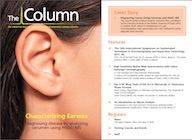High Sensitivity Native Mass Spectrometry with Cation Exchange Chromatography
The Column
The utility of native high-resolution mass spectrometry (HRMS) in intact protein characterization is rapidly growing because of advances in both ion-exchange chromatography (IEC) as well as MS-compatible buffer systems. MS is a critical component of biotherapeutic characterization, but its combination with traditional chromatographic separations, such as size-exclusion chromatography (SEC) and IEC, has been slow because of the predominant use of high salt mobile phases, which are incompatible with MS. Recently reported methods using cation-exchange chromatography (CEX) with volatile buffer systems for pH gradient elution has given researchers the ability to use these chromatographic techniques with MS detection. In this article a robust, MS-compatible buffer system for high sensitivity IEC with pH gradient elution for charge variant analysis of intact monoclonal antibodies (mAbs) is described.
ustas / stock.adobe.com
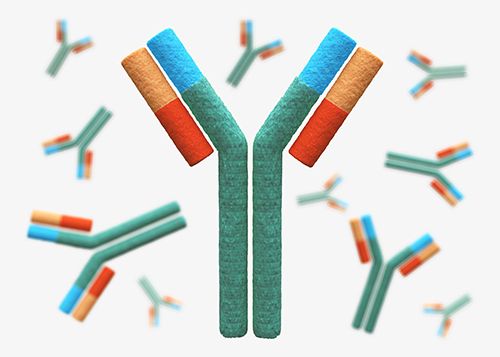
The utility of native high-resolution mass spectrometry (HRMS) in intact protein characterization is rapidly growing because of advances in both ion-exchange chromatography (IEC) as well as MS-compatible buffer systems. MS is a critical component of biotherapeutic characterization, but its combination with traditional chromatographic separations, such as size-exclusion chromatography (SEC) and IEC, has been slow because of the predominant use of high salt mobile phases, which are incompatible with MS. Recently reported methods using cation-exchange chromatography (CEX) with volatile buffer systems for pH gradient elution has given researchers the ability to use these chromatographic techniques with MS detection. In this article a robust, MS-compatible buffer system for high sensitivity IEC with pH gradient elution for charge variant analysis of intact monoclonal antibodies (mAbs) is described.
Protein heterogeneity is a wellâknown characteristic of biotherapeutic development. Within the process of recombinant monoclonal antibody (mAb) production, charge variants of the final product are introduced through post-translational modification (PTM) mechanisms. To ensure product quality, regulatory agencies refer to the ICH Q6B guideline requiring analytical confirmation that protein heterogeneity does not exceed a defined threshold (1). The analytical methods to characterize and monitor multiple production lots are extensive and complex. For charge variants, two complementary methods, ionâexchange chromatography (IEC) and capillary electrophoresis (CE), are typically used.
As the name infers, protein charge variants are protein species with different charge states on the exposed protein surface. The additional charges are caused by the addition, deletion, or modification of acidic or basic amino acid residues. Common PTMs creating these residues are C-terminal lysine clipping, deamidation, and glycosylation. Electrophoretic methods to analyze charge variants include capillary zone electrophoresis (CZE), capillary isoelectric focusing (cIEF), imaged capillary isoelectric focusing (icIEF), and free-flow electrophoresis (FFE) (2). In general, these methods separate the charged analytes based on differences in electrophoretic mobility using applied electric field (CZE) or differences in the isoelectric point of the analytes (cIEF). Electrophoretic methods can also be attached to mass spectrometry (MS) instrumentation for rapid proteoform identification (3).
The more common approach for charge variant analysis is through IEC. Mechanistically, the charge variants are separated through electrostatic interaction with an oppositely charged surface. Cation exchange chromatography (CEX) is the preferred media for mAbs because the chromatographic media contains a negative charge under the mobile phase pH systems employed. Either strong cation exchange chromatography (SCX) with a sulfonated surface or weak cation exchange chromatography (WCX) with a carboxylated surface are used for mAb charge variant analysis where a pH or salt mobile phase gradient is used to mediate the surface charge–analyte interactions and thus elute the charged analytes as separate bands (4). As a result of the high salt or nonvolatile buffers used in these protocols, MS has not been widely used as a detection method for charge variant analysis with IEC. Recent methods (5,6) using volatile buffer systems for pH gradient elution with CEX have been reported. This article expands on previous work by demonstrating the sensitivity and reproducibility provided by a novel robust buffer system for charge variant analysis of intact mAbs using WCX with native highâresolution MS detection.
Materials and Methods
Ammonium acetate, 99.999% trace metals basis, was purchased from Sigma-Aldrich. Acetic acid and ammonium hydroxide, ≥ 99.99% trace metals basis, were also purchased from Sigma-Aldrich. Mobile phase A was 20 mM ammonium acetate adjusted to pH 5.2 with acetic acid. Mobile phase B was 5-mm ammonium acetate adjusted to pH 10.15 with ammonium hydroxide. Trastuzumab was purchased from Myoderm.
Experiments were performed using a 250 × 2.1 mm bioZen 6 µm WCX column (Phenomenex, Inc.)
Separations were performed using an Agilent 1290 infinity II LC system with binary pump, multisampler, and multicolumn thermostat. Mass spectrometric detection was performed using a Sciex X500B QTOF instrument.
Experimental Conditions for Trastuzumab Charge Variant Analysis:
Liquid Chromatography (LC) Conditions: flow rate: 0.2mL/min; temperature: 30 °C; injection volume: 10-µL (100âµg onâcolumn); mobile phase A: 20-mM NH4Ac, pH 5.2; mobile phase B: 5-mM NH4Ac, pH 10.2
Gradient: 0.00 min, 80%A, 20%B, 0.2 mL/min; 3.00 min, 80%A, 20%B, 0.2 mL/min; 28.00 min, 50%A, 50%B, 0.2 mL/min; 28.01 min, 0%A, 100%B, 0.2 mL/min; 40.50 min, 0%A, 100%B, 0.2 mL/min; 40.51 min, 80%A, 20%B, 0.2 mL/min; 65.00 min, 80%A, 20%B, 0.2 mL/min.
MS Conditions: temperature: 500 °C; DP: 250; CE: 15; ISV: 4500; scan range: 2000–7000.
Results and Discussion
Development of Novel, Robust pH Gradient Buffer System: One of the primary considerations when developing the pH gradient buffer system was ensuring day-to-day separation robustness, that is, retention time and peak area reproducibility. Robustness was accomplished by using the lowest practical ionic strength that still provided good buffer capacity. The lowest practical ionic strength was determined by several factors including pH stability, equilibration time, and MS sensitivity. A 20-mM NH4Ac concentration at pH 5.2 was chosen for the low pH buffer and a 5-mM NH4Ac concentration at pH 10.15 was chosen for the high pH buffer. This combination satisfied the above considerations while also giving reasonable pH linearity in the region required for mAbs with a low isoelectric point (pI). Additionally, the higher ionic strength of the low pH mobile phase ensured rapid column equilibration while the lower ionic strength of the high pH mobile phase helped improve MS sensitivity. The ratio of ionic strengths used in the buffer composition also allowed for control of mobile phase pH by requiring a significant change in the percentage of high pH buffer to change the mobile phase pH.
The pH and appearance of two different preparations of both mobile phases were monitored over the course of two weeks use at room temperature. MS sensitivity and chromatographic performance were also monitored during the two-week lifetime of the buffers. A mobile phase reservoir inlet air filter was used on all reservoirs to prevent ambient microbial contamination of the mobile phases. No microbial growth and no significant change in pH was observed over the twoâweek period indicating good stability. The pH of the two low pH mobile phases initially measured 5.24 and 5.26. After two weeks the pH buffers were 5.26 and 5.27, respectively, which are within experimental error and thus demonstrate good pH stability. The pH of the two high pH mobile phases initially measured 10.16 and 10.19. After two weeks the pHs were 10.15 and 10.14, respectively, which are within experimental error and thus also demonstrate good pH stability. No change in MS sensitivity or chromatographic performance was observed over the twoâweek period of use, further demonstrating stability of the buffer system (Figure 1). Plastic mobile phase reservoirs and mobile phase reservoir filters were used to prevent leaching of sodium from glass components.
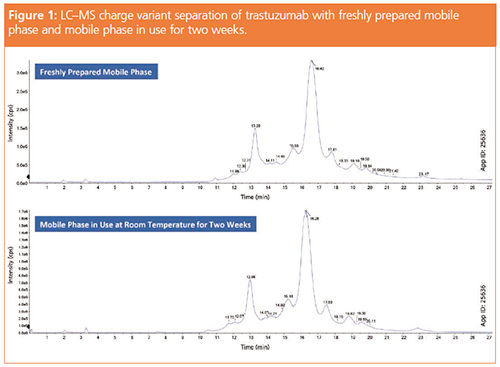
Demonstration of Utility Using Trastuzumab: Figure 2 shows the separation of trastuzumab charge variants obtained using the WCX column and the optimized buffer system. All experimental conditions are provided above. The chromatographic conditions give a very detailed separation of trastuzumab charge variants and isoforms with good MS sensitivity. The raw and deconvoluted mass spectra for the main peak are shown in the figure. The primary glycoforms of the main peak are also identified along with their mass error. As shown in Figure 3, a low-level lysine variant (+1 lysine) is also identified with good sensitivity and mass accuracy. Spectral overlap of the lysine variant with main peak glycoforms (ex. +1 lysine G0F/G0F variant spectrum overlaps with G0F/G1F) is indicated in the deconvoluted mass spectrum, which indicates coelution of a minor isoform with the same mass spectrum as the main peak.
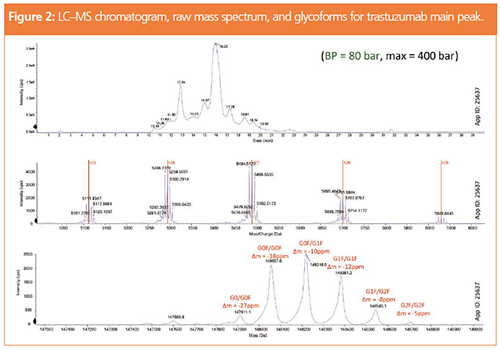
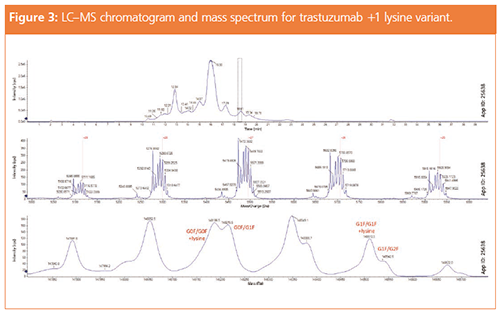
Conclusion
A pH gradient buffer system using MSâcompatible, volatile components was optimized to give robust, high sensitivity charge variant analyses of mAbs using IEC with native high-resolution MS. The buffers were shown to maintain stable pHs, charge variant retention times, and MS sensitivity when used at room temperature over a two-week period. The optimized buffer system allows for routine monitoring and identification of mAb charge variants using IEC coupled on-line to native highâresolution MS. This study provides a significant improvement in routine quality monitoring of biotherapeutics by allowing rapid identification of any new charge variants.
References
- International Conference on Harmonization, ICH Harmonized Tripartite Guideline: Specifications: Test Procedures And Acceptance Criteria for Biotechnological/Biological Products (Q6B) (ICH, Geneva, Switzerland, 1999).
- A. Turner and J.E. Schiel, Analytical and Bioanalytical Chemistry410(8), 2079–2093 (2018).
- X. Shen, Z. Yang, E.N. McCool, R.A. Lubeckyj, D. Chen, and L. Sun, TrAC Trends in Analytical Chemistry 120, 115644 (2019).
- A. Murisier, E. Farasang, K. Horvath, M. Lauber, A. Beck, D. Guillarme, and S. Fekete, Journal of Pharmaceutical and Biopharmaceutical Analysis172, 320–328 (2019).
- A.C. Sanchez and T. Farkas, “Exploring charge variant analysis of native monoclonal antibodies using LC-online high-resolution MS with pH gradients and various cation exchange columns,” paper presented at HPLC 2019, Milan, Italy, 2019.
- F. Füssl, K. Cook, K. Scheffler, A. Farrell, S. Mittermayr, and J. Bones, Anal. Chem. 89, 4669–4676 (2018).
A. Carl Sanchez is a Senior Research Scientist in Phenomenex R&D where he manages a group that provides advanced technical problem-solving support to Phenomenex businesses as well as advanced troubleshooting support to customers. Additionally, Carl’s group is actively involved in new product development projects spanning HPLC, sample preparation, and GC. Carl has authored multiple papers on HPLC in peer-reviewed journals as well as given over 100 lectures at scientific conferences worldwide. Carl’s current research interests include LC–MS characterization of biotherapeutics as well as evaluating and understanding the kinetic performance of HPLC sorbents.
Chad Eichman is the Global Business Unit Manager – Biopharmaceuticals at Phenomenex, Inc. where he develops and leads the strategic plans for Phenomenex’s biopharmaceutical business. He received his B.S. in chemistry from the University of Wisconsin-Madison (USA) and his Ph.D. in organic chemistry from The Ohio State University (USA). After a postdoctoral appointment at Northwestern University (USA) and an assistant professorship at Loyola University Chicago (USA), Chad joined Phenomenex in 2017.
E-mail:chade@phenomenex.comWebsite:www.phenomenex.com/bioZen
